
8. Chirality & Helicity
Recommended by Prof. Shuang-Quan Zang
Chiral structures not only exist in nature widely, but they also emerge in artificial systems, attracting myriad attention due to their excellent mechanical, optical, electrical, and magnetic properties. Recent aggregology studies related to chirality and helicity are summarized in this collection.
2024
Helicene‐type β‐isoindigo‐based boron‐dipyrromethene analogs with strong near‐infrared chiroptical activity
Circularly polarized luminescence from a common alkoxy pillar[5]arene and its co‐aggregates with π‐conjugated rods
Graphical Abstract
![Circularly polarized luminescence from a common alkoxy pillar[5]arene and its co-aggregates with π-conjugated rods Issue 3, 2024](/cms/asset/3f810e38-eb48-452d-ba44-fbe45fdd67c7/agt2482-gra-0001-m.jpg)
Circularly polarized luminescence (CPL) properties are investigated for pillar[5]arene, a chiral macrocycle with stable planar chirality, and its combination with a rod-shaped π-conjugated molecule. In tetrahydrofuran/H2O, the two components form co-aggregate due to a hydrophobic effect. The co-aggregate affords low-energy photo-absorption and luminescence, which is effectively polarized with the highest CPL dissymmetry factor of 2.9 × 10−2 among pillar[n]arenes.
Superatomic‐based chirality: Asymmetric structures constructed by superatoms
Graphical Abstract
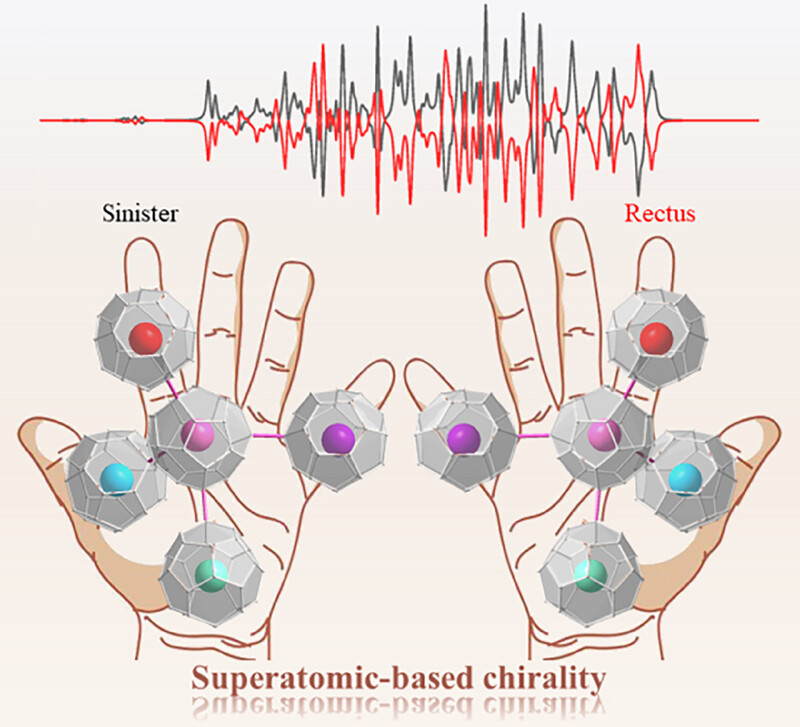
The assembly of chiral structures using superatoms as building blocks is reported for the first time. The success of this assembly depends on the bonding properties of superatoms, leading to the emergence of a distinct form of chirality named “superatomic-based chirality”. With the abundance of superatoms, there is considerable anticipation for the significant expansion of chiral structures at the atomic level.
Homochiral metalated tetraphenylethylene‐based organic cages: Unusual chiral and luminescent behavior depending on thermodynamic and kinetic aggregation
Graphical Abstract
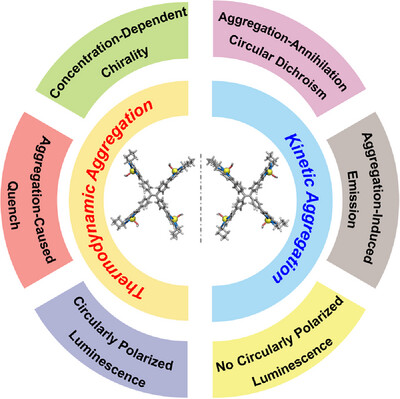
A pair of metalated tetraphenylethylene-based organic cage enantiomers have been successfully synthesized and characterized. Upon undergoing thermodynamic or kinetic aggregation, these cages exhibit unique photophysical behaviors, including concentration-dependent chirality, aggregation-annihilation circular dichroism, aggregation-caused quench emission, aggregation-induced emission, and circularly polarized luminescence.
Revealing the regulation of water dipole potential to aggregation of amyloid‐β 42 at chiral interface by surface‐enhanced infrared absorption spectroscopy
Graphical Abstract
Host–guest complexation‐induced chirality switching of pillararenes by perylene diimide‐based hexagonal metallacages
Graphical Abstract
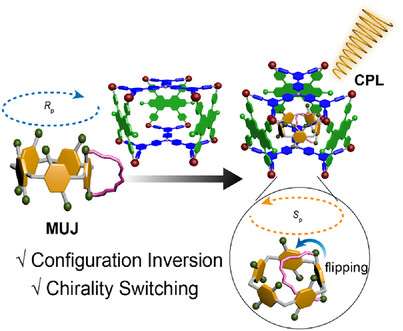
Hexagonal perylene diimide-based metallacages with spacious cavities for binding pillararenes were prepared. Employing a chiral pillar[5]arene-based molecular universal joint as a guest, the complexation induced alkyl chain flipping within the pillar[5]arene unit, changing the configuration and the chirality of the system. this also triggered circularly polarized luminescence emission from the metallacages.
Full‐color‐tunable chiral aggregation‐induced emission fluorophores with tailored propeller chirality and their circularly polarized luminescence
Graphical Abstract

Modular synthesis toward chiral macrocyclic AIEgens with tailored propeller chirality and customized emission color was well established, whereas full-spectra-tunable circularly polarized luminescent emission could be realized via donor-acceptor engineering on AIEgens or matrix engineering with a diverse polymer film.
Multifaceted regulation of chiroptical properties and self‐assembly behaviors of chiral fluorescent polymers
Graphical Abstract
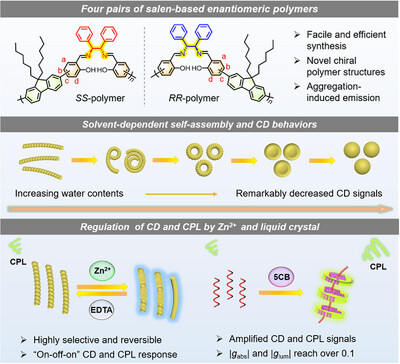
A series of novel salen-based chiral fluorescent polymers with aggregation-induced emission and varied substitution manners were facilely and efficiently synthesized. The effects of molecular structures, solvent environments, metal coordination, and liquid crystal assemblies on the chiroptical properties and self-assembly performance of these polymers were systematically investigated.
Aggregation‐induced circularly polarized luminescence and delayed fluorescence enabled by activating high‐level reverse intersystem crossing
Chiral‐induced highly efficient NIR–photothermal conversion of perylene diimide@silica nanocapsules for photothermal therapy
Graphical Abstract
Ultrafast Excitonic Transitions in Enantiopure and Racemic Squaraine Thin Films
Graphical Abstract
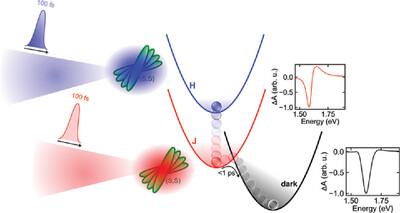
Ultrafast optical excitation of both J- and H-like bands in enantiopure ProSQ-C16 thin films leads to highly similar spectral and dynamic responses, suggesting that a single aggregate type is responsible for the excitonic properties such as the giant circular dichroism reported previously. A rapid transition to a dark intermediate state involving both intermolecular charge transfer and a conical intersection could be accountable for the low photoluminescence quantum yield in the J-like aggregate.
Cellulose‐Based Switchable Circularly Polarized Light Emitter: Photo‐Actuated Chiral Assemblies With Azobenzene Polymers
Graphical Abstract
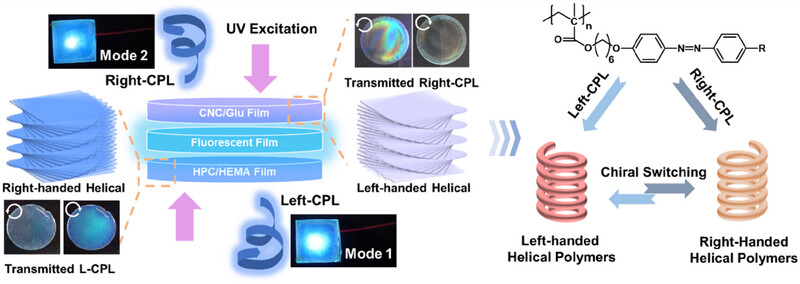
Inserting a luminescent layer between two cellulose derivative films with opposite chiral structures to prepare a chiral-switchable circularly polarized light emitter. The circularly polarized light emitter can be applied to precisely regulate the chiral helix of the azobenzene supramolecular polymers.
Bimerons create bimerons: Proliferation and aggregation induced by currents and magnetic fields
Graphical Abstract

Bimerons are a famous type of topologically protected spin textures in chiral magnets. An in-plane current can induce the proliferation and aggregation of bimerons in the presence of a suitable out-of-plane magnetic field, which suggests a new platform for studying aggregation-induced effects in condensed matter systems.
2023
Aggregation‐induced emission polymer systems with circularly polarized luminescence
Graphical Abstract
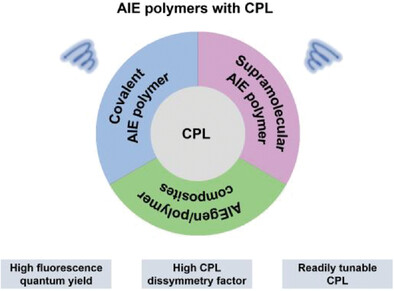
Aggregation-induced emission (AIE) polymer systems with circularly polarized luminescence (CPL) have significant advantages in terms of fluorescence quantum yields, dissymmetry factor, and readily tunable CPL activity. This review discusses the recent progress on CPL-active AIE polymers, including CPL-active covalent AIE polymers, CPL-active supramolecular AIE polymers, and AIEgen/polymer composites with CPL.
A chiral spirofluorene‐embedded multiple‐resonance thermally activated delayed fluorescence emitter for efficient pure‐green circularly polarized electroluminescence
Graphical Abstract
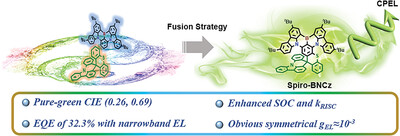
The integration of chiral S-substituted spirofluorene structure and B/N skeleton has proven to be an effective approach for achieving pure-green emission and symmetric CPL. The corresponding CP-OLEDs demonstrate a remarkable EQE of 32.3% and symmetric CPEL with gEL factors approximately on the order of 10-3.
Stimulating and harnessing circularly polarized luminescence of helically assembled carbonized polymer dots via interfacial dynamics
Graphical Abstract
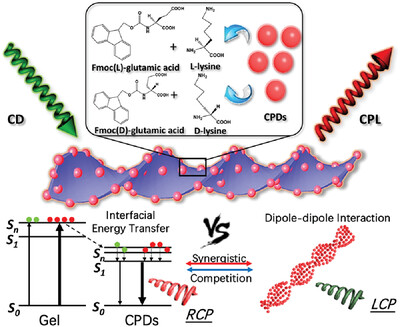
Surface states-related CD/CPL behaviors of helically assembled carbonized polymer dots are observed and manipulated via interfacial dynamics. The excitation-dependent CPL activities are closely related to a synergistic-competition phenomenon between interfacial energy transfer and dipole–dipole interactions. These findings provide unique insights to the interfacial emission properties of host–guest nano-luminophores.
2022
Unique three-component co-assembly among AIEgen, L-GSH, and Ag+ for the formation of helical nanowires
Graphical Abstract
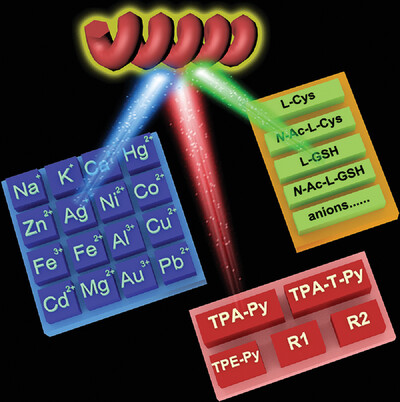
The ternary co-assembly of L-GSH, AgNO3, and an AIEgen TPA-Py is highly precise and specific through an extensive study about their analogues, which gives a fast and visual signal output by dramatic fluorescent enhancement. The ternary co-assembly show unique chirality sense, which suggests that the molecular chirality of L-GSH is transferred and amplified into the supramolecular helicity level.
Supramolecular chiral polymeric aggregates: Construction and applications
Graphical Abstract
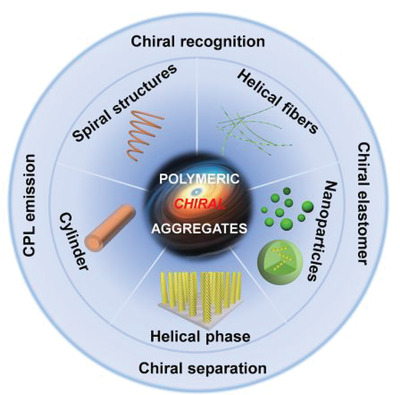
Recently polymers become excellent candidates to construct artificial chiral aggregates, due to the diverse conformations and components. Although regulating the chiral morphology is challenging in polymer aggregates, it attracts lots of research interests because of its crucial role in applications. Herein, this review summarizes typical examples of construction methods of supramolecular chirality in aggregated state and their applications.
Visualization of enantioselective recognition and separation of chiral acids by aggregation‐induced emission chiral diamine
Graphical Abstract
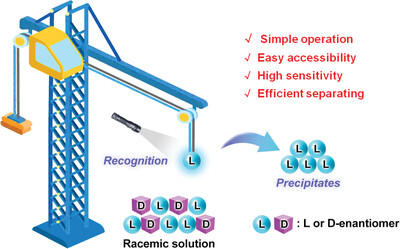
A pair of optically active diamine with AIE characteristics were developed which can discriminate 5 kinds of chiral acids. Especially, a very high fluorescence intensity ratio (Il/Id) of 281 for (±)-Dibenzoyl-d/l-tartaric acid through formation AIEgen/acid complexes. The enantioselective separation was carried out by using the chiral AIEgens, which enantiomer separation efficiency of (−)-Dibenzoyl-l-tartaric acid was calculated to be 82% in the precipitates.
Unconventional assemblies of bisacylhydrazones: The role of water for circularly polarized luminescence
Circularly polarized luminescence of coordination aggregates
Graphical Abstract
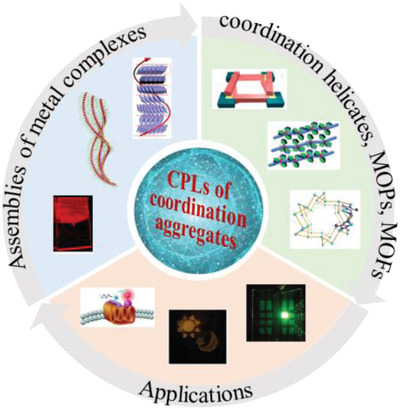
The recent progress in the development of circularly polarized luminescence (CPL)-active aggregates of metal-ligand coordination materials is summarized, including those based on discrete chiral metal complexes, chiral metal-ligand helicates, and coordination polymers and frameworks. The applications of these materials in circularly polarized organic light-emitting diodes and CPL-contrast imaging and probes are further discussed.
Chiral porphyrin assemblies
Graphical Abstract
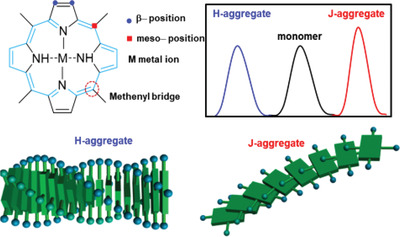
The study of the chiral assembly of porphyrins can aid biomimetic research and the exploration of functional materials. In this review, recent developments of chiral porphyrins assemblies are highlighted. We also provide an overview of the applications of chiral porphyrin assemblies in the fields of sensing, catalysis, and optics.
Spatially resolved chiroptical study of thin films of benzo[1,2-b:4,5-b’]dithiophene-based oligothiophenes by synchrotron radiation electronic circular dichroism imaging (SR-ECDi) technique
2021
Endowing inorganic nanomaterials with circularly polarized luminescence
Graphical Abstract

Circularly polarized luminescence (CPL) inorganic nanomaterials have attracted much attention due to their widespread application in various fields. Several kinds of inorganic nanostructures with CPL activity are reviewed in detail, including intrinsic chirality, ligand-induced chirality, and structural chirality caused by the supramolecular assembly. The related applications of CPL-active inorganic materials in enantioselective photopolymerization, optical information processing, and chemical sensing are summarized.
Circularly polarized luminescence of agglomerate emitters
Graphical Abstract
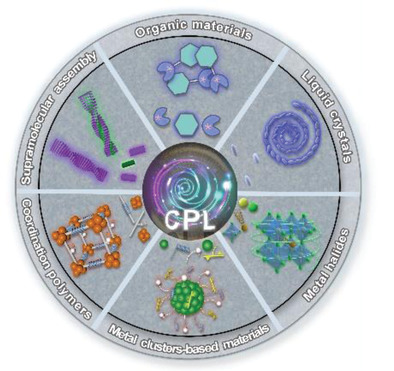
In this review, besides the fundamental principles of circularly polarized luminescence (CPL), CPL measurement methods for solid-state samples and the recent progress of the diverse agglomerate CPL-emitters, including organic materials, crystalline metal-organic materials (coordination polymers, organic–inorganic metal halides, metal clusters, and cluster-assembled materials), supramolecular ensembles, and liquid crystals are summarized. The opportunities and challenges of CPL-emitters in agglomerate state are presented.
Chiral transfer‐dictated self‐assembly of chiral block copolymers
Graphical Abstract
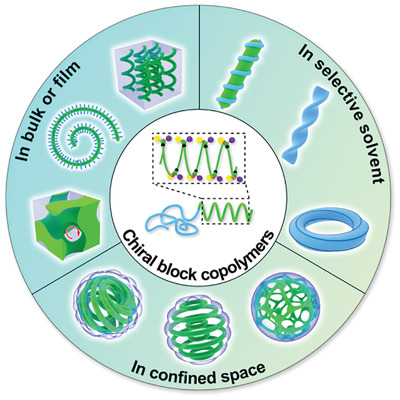
The self-assembly of chiral block copolymers (BCPs*) represents a facile access to controllable chiral structures. In this review, we presented the self-assembly of BCPs* in bulk/films, selective solvents, and confined spaces. The chiral transfer process in these assembly scenarios were discussed and highlighted as a key contributor to the morphological chirality.
Circularly polarized luminescent self‐organized helical superstructures: From materials and stimulus‐responsiveness to applications
Graphical Abstract
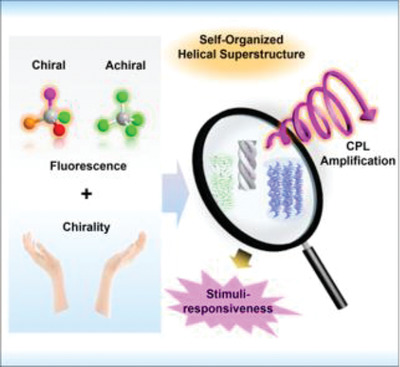
Cholesteric liquid crystals (CLCs) with self-organized helical superstructures have exhibited considerable advantages in terms of achieving high luminescence dissymmetry factors and tunable circularly polarized luminescence (CPL) properties. This review highlights the recent developments in CLC-based CPL-active materials doped with various emitters. In addition, stimulus-responsive CPL based on emissive CLCs is systematically summarized.
High‐performance nano‐splitters containing aggregation‐induced emission luminogens for stereoselective crystallization obtained via polymerization‐induced self‐assembly
Graphical Abstract
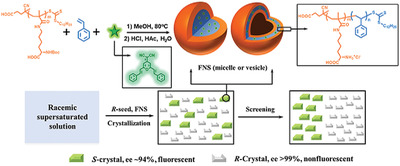
We report the first nano-splitters containing aggregation induced emission luminogens prepared via polymerization-induced self-assembly of block copolymer. When added into the supersaturated solution of racemic amino acids with seeds, the fluorescent labeled nano-assemblies enantioselectively dyed the S-crystals and enabled the separation from colorless R-crystals in terms of fluorescent difference. Both enantiomers were obtained with high optical purity and yield. Owing to a low detection limit of fluorescence, the addition amount was reduced to 0.03 wt% without remarkably compromising the ee values of both enantiomorphs. Combining with low addition amount and efficient synthesis, the output-input ratio can be increased greatly.




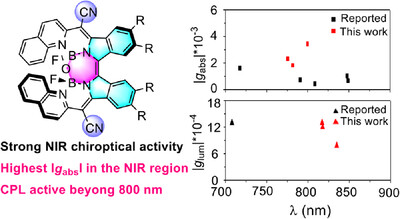
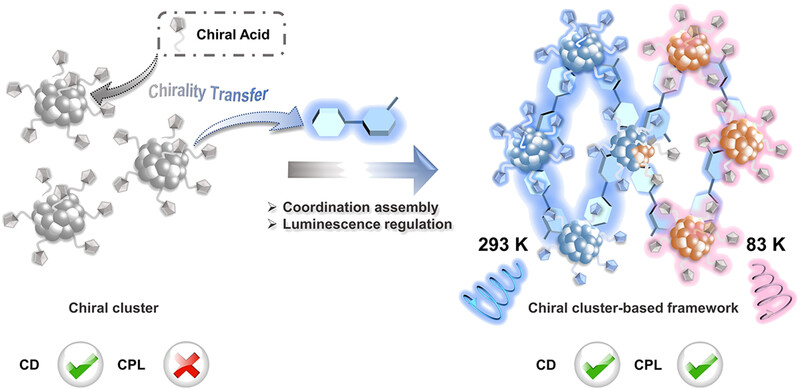

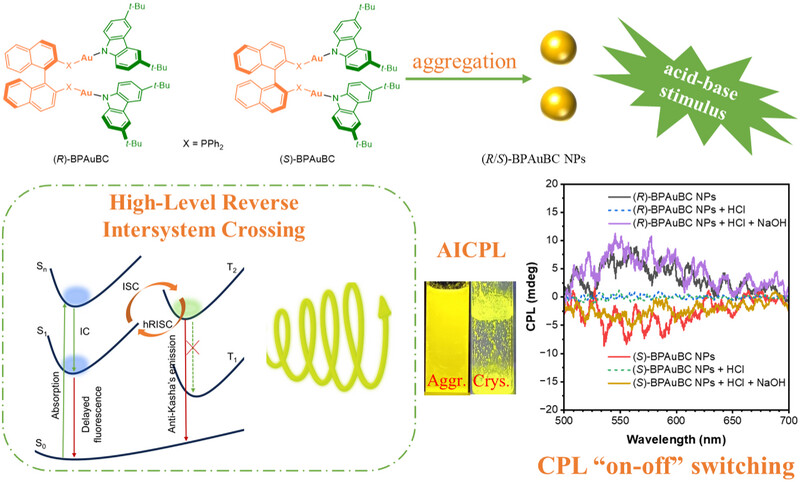
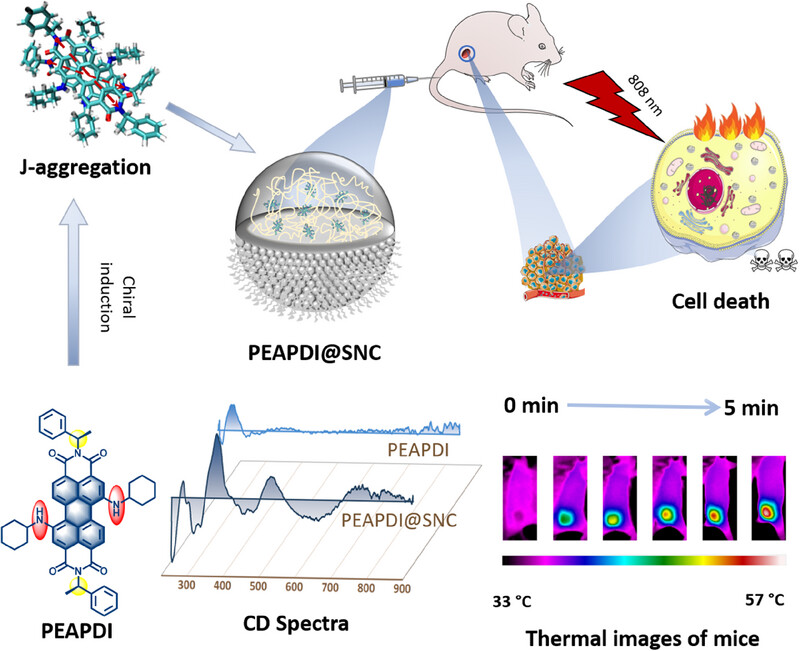
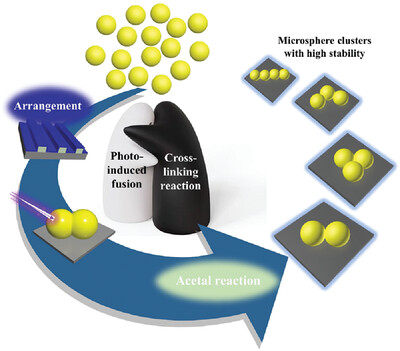
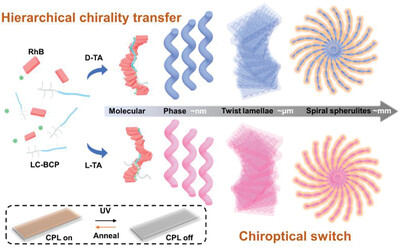
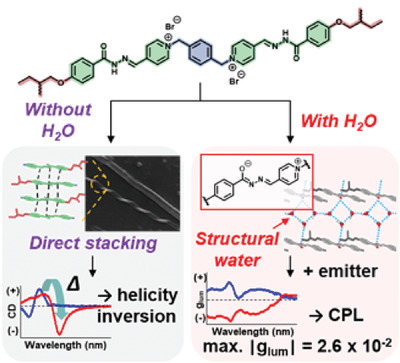
![Spatially resolved chiroptical study of thin films of benzo[1,2-b:4,5-b’]dithiophene-based oligothiophenes by synchrotron radiation electronic circular dichroism imaging (SR-ECDi) technique Issue 5, 2022](/cms/asset/4c1e0818-44e4-407c-997b-1b226b44284d/agt2193-gra-0001-m.jpg)